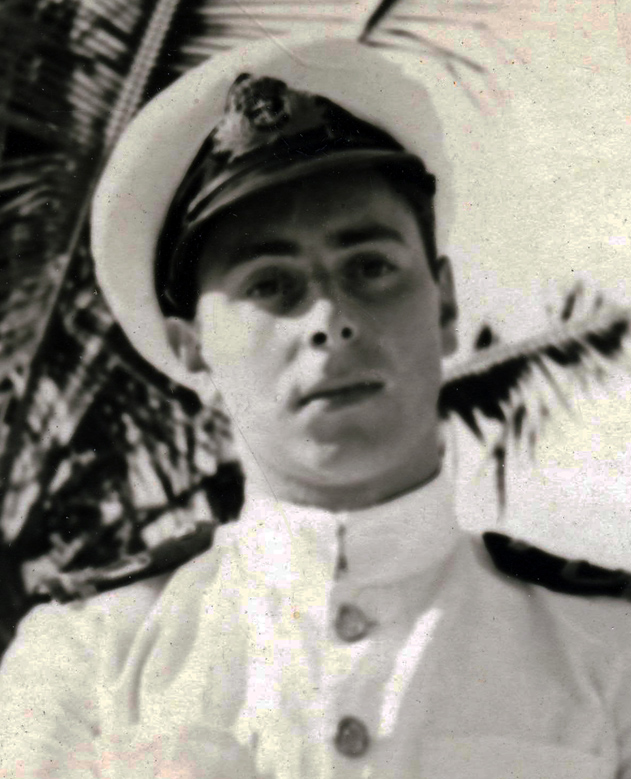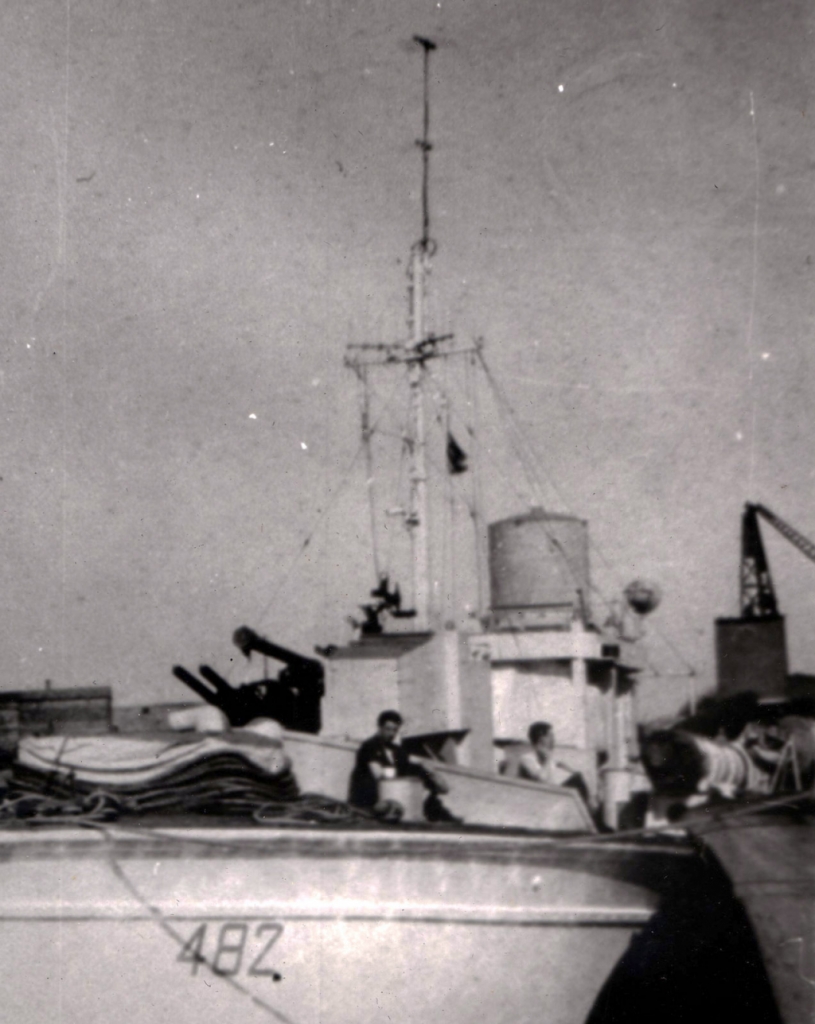This description is part of the memoirs of Lt Bernard "Bunny" Lacome, he owns the copyright of this text and it must not be reproduced without his permission. A description of his wartime service can be viewed in "Unit Histories" on-line. Choose the Union Jack, then Royal Navy, then RNVR, then scroll down to Lacome.
This picture was taken in Bombay in 1945 where "Bunny" was the Port Radar Officer
The MTBs’ radar sets worked on the 10cm waveband, and although at the start of the war the Germans had no radar of their own they quickly discovered that the Allies had radar. As a countermeasure, the Germans built listening devices so that they could hear the transmissions when our radar was on. To our great disadvantage, the Germans could hear us from more than twice the distance our radar could detect them. They could also determine with some accuracy the direction the radar signal was coming from, and by using two, or sometimes three, listening devices, they could triangulate and fairly well pinpoint the location of an MTB when it turned its radar on.
The dry-dock at H.M.S. Beehive was located in a huge hangar that our shipwrights shared with the Royal Air Force (RAF). The RAF used the hanger to service two Catalina flying boats that carried out aerial reconnaissance over the English Channel and the Atlantic Ocean. In the late spring of 1944, the Catalinas were fitted with new radar equipment (AN/APS) that operated on the 3cm waveband, an American development remarkable for its detailed accuracy. As luck would have it, the RAF had a spare AN/APS in an unopened crate just in case they had to exchange a piece of equipment or cannibalize a part should a set on the Catalinas break down.
Unlike MTBs, Catalinas did not have problems with damp. So, when the crated AN/APS sat unopened for a few months we approached the RAF chappies and persuaded them to let us install their spare 3cm set on one of our MTBs. No sooner said than done! The idea was well received. Jack Breadner and I went to see Lt.Cdr. Lillicrap, Beehive’s shipwright-in-chief, with a proposal for him to build a tower to mount the AN/APS on one of our boats.
An important consideration was not to increase the size of the boat’s silhouette; that is, to keep the tower as low as possible. From a technical point of view, doubling the height of a radar tower only increases the signal strength by 40 per cent. With this in mind, and because the AN/APS would only be used to scan the ocean by night for comparatively short distances, perhaps no more than twice the line of sight in good weather, we settled on a tower as low as practically possible. After much discussion we all agreed the base of the tower’s platform should be just high enough not to obstruct the skipper’s all-round view from the bridge, and no more.
While the shipwrights worked on the construction of the tower, Jack and I unpacked the crate and assembled the AN/APS on a table in the forecourt of our workshop and pointed it toward the Continent. The day was excellent for working outdoors – almost cloudless, bright sunshine shimmering across the surface of a glass calm sea. We followed the instruction manual, connected the cables between the supply box, the radar unit and the display screen. Next step, with our eyes glued to the screen, we turned switches on in the correct order. Lo and behold we had a radar image. At short range we could identify boats moored close by in the harbour, the harbour entrance and the surrounding buildings. We increased the range and saw boats and buoys beyond the harbour entrance. Some ships and boats beyond our sight range were also visible on the screen. Out of curiosity, we increased the range again.
Catalinas, from the air, scanned an area up to about 200 miles in front of them with the AN/APS. The MTBs’ radar, on the other hand, rarely picked up useful signals beyond ten miles. Imagine our surprise when we not only detected the outline of the coast between Ostend and the Hook of Holland but also saw moving dots representing vessels in motion.
This amazing sight was far better than we had expected and has to be described as an anomaly – a highly unusual event. The images on the radar screen that day can be likened to a mirage in a desert. The heat of the day affected the air layers above the sea surface between Felixstowe and the Dutch coast and bent the radar beam. All the staff on duty came to look at the phenomenon while it lasted. Then we dismantled everything and put the pieces back in the crate. The next step was to prepare the MTB to accommodate the AN/APS. Our plan was to install the radar screen on the bridge. That way the skipper could see the images for himself instead of having to rely on verbal reports from the telegraphist/bunts/radar operator in his cabin below deck.
Radar Dome on MTB 482
The MTB came out of dry-dock with a squat looking platform just abaft the bridge. On the platform was an opaque plastic cylinder about four feet in diameter and roughly three feet tall. A hatch, or manhole, in the platform provided just enough space to pass the AN/APS through followed by a person (me) to fix the parts in place, attach the cables, seal gaps with Bostick to make the cylinder watertight, and then retreat fixing the hatch in place. That was the plan.
On the day of the installation we wheeled the AN/APS on a trolley. My guess now is that the principal unit – in the shape of a fibreglass Easter egg on a low pedestal – weighed about 110 pounds. We asked the crane operator responsible for moving objects of this size from the dockside to the deck of a boat to make the transfer for us. The chosen MTB was the third or fourth from the dockside. The tide was low. If the tide had been high and the MTB was alongside the dock, two or three or four of us would have carried the egg on board by hand.
So we passed the Easter egg on its pedestal to the stevedores who “secured” it with a sling, fastened a hook to the sling and signalled the man aloft in the control booth to start lifting. Too late for Jack or me to do anything. The moment the egg left the ground the loops of the sling began to slide sideways until from a height of about twelve feet the egg came loose and fell to the ground. The fat end of the fibreglass egg was crushed and when we got the wreckage back to the workbench we found the innards in bad shape.
The good news is that for the most part the circuit components were standard parts. We could replace broken vacuum tubes, broken resistors, crushed condensers, and reattach loose wires. The bad news is that the frame or chassis on which the components were mounted, and the broken insulators were designed specifically for the AN/APS. We had no replacements. The now broken set was intended to provide replacement parts for the installations on the Catalinas.
We could think of only one solution. I took the set apart section-by-section, piece-by-piece. The nuts, machine screws and washers were undamaged. Ha! Ha! Some portions of circuit boards were still intact, but a twelve-foot fall was too much for the now fractured and distorted metal framework. I straightened what I could. I scrounged material to make replacements when I couldn’t repair. For instance, I could not repair broken aluminium brackets, so had to make new brackets out of sheet aluminium or brass. I obtained slabs and rods of micalex and perspex to replace broken circuit boards and insulators. I cut shapes from the sheet micalex. I drilled holes. I turned micalex rods on the lathe in the ASDIC workshop to replace broken insulator posts. I checked components to see if they still worked, and replaced them when they didn’t. In one respect, luck was on our side. Some specially designed parts called transformers were all undamaged. Fortunately, they were mounted in small metal boxes to shield them from radiation, and the boxes saved them. If the transformers had been damaged we might have been beaten.
Two weeks or so passed while I carried out repairs. I can recall that no one hovered over me during this time. Then I was ready to start putting bits and pieces back together. I lined up my tools – screwdrivers, pliers, small wrenches, soldering iron, etc. – and went to work. Gradually, resistors, condensers, inductance coils and vacuum tubes were mounted on the rebuilt frame. Nothing was left over. Nothing seemed to be missing. Remarkable!
The time had come to find out if AN/APS would work again. Jack Breadner joined me after I soldered the final wires in place, and we moved everything out to the forecourt to see what would happen when we turn the set on.
It worked! No long range view of boats off Ostend Harbour, though. The weather was not good enough. Boats and buoys within a 20-mile range appeared on the radar screen where they were supposed to be.
The broken fibreglass shell was the least of our worries. When installed on the MTB the shell would be weather protected inside the plastic cylinder. We patched the shell inside and out with brown paper and Bostick. We used Bostick for all sorts of things, but never tried making Bostick tea.
MTB 482, skippered by Lt. “Bertie” Smail, senior officer of the 35thMTB Flotilla, had been chosen for the installation. This time we made sure he moored his boat adjacent to the dock. At high tide a small procession moved from our workshop to Smail’s boat carefully carrying the cables and the three essential parts – power supply, radar screen, and the radar set in its Easter egg capsule. If only we had been equally careful the first time.
This episode has a happy ending, or an unhappy ending, depending on who tells the story. On Smail’s first sortie with the AN/APS he located an E-boat, crept up on her and sank her. He rescued survivors from the sea. To our knowledge, the Germans never found out that we had 3cm radar on one of our MTBs.
Bernard "Bunny" Lacome Lt (L) RCN Retd
More photos of 482 and the Radar can be seen on the "Gallery of MTB's 2" page
|






